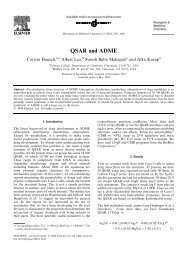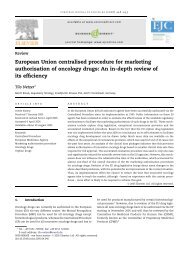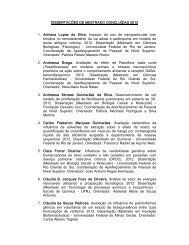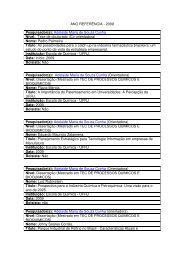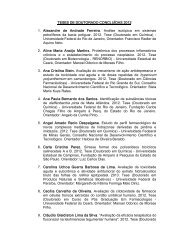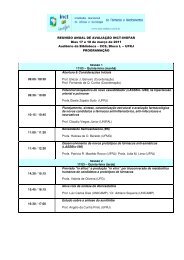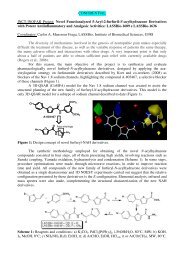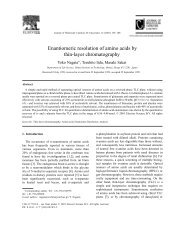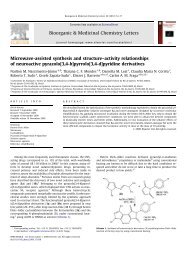View - ResearchGate
View - ResearchGate
View - ResearchGate
- No tags were found...
Create successful ePaper yourself
Turn your PDF publications into a flip-book with our unique Google optimized e-Paper software.
© Copyright 2004 by the American Chemical SocietyVolume 47, Number 18 August 26, 2004PerspectiveDiscovering Drugs through Biological Transformation: Role ofPharmacologically Active Metabolites in Drug DiscoveryAberra Fura,* ,† Yue-Zhong Shu, ‡ Mingshe Zhu, § Ronald L. Hanson, # Vikram Roongta, § andW. Griffith Humphreys †Bristol Myers Squibb, Pharmaceutical Research Institute, P.O. Box 5400, Princeton, New Jersey 08534,Bristol-Myers Squibb, Pharmaceutical Research Institute, 5 Research Parkway, Wallingford, Connecticut 06492,Bristol Myers Squibb, Pharmaceutical Research Institute, P.O. Box 4000, Princeton, New Jersey 08543, andBristol-Myers Squibb, Pharmaceutical Research Institute, One Squibb Drive, New Brunswick, New Jersey 08903Received March 18, 2004IntroductionIn most cases, the metabolism of drugs leads topharmacological inactivation through biotransformationto therapeutically inactive molecules. However, drugmetabolism can also result in pharmacological activation,where pharmacologically active metabolites aregenerated. 1-3 Although formation of pharmacologicallyactive metabolites (bioactivation) can be mediated byboth phase I (oxidation, reduction, and hydrolysis) andphase II (conjugation reactions) metabolism, bioactivationresulting from phase I metabolism mediated bycytochrome P450 (CYP) enzymes is the most commonpathway.Active metabolites may have superior pharmacological,pharmacokinetic, and safety profiles compared totheir respective parent molecules. As a result, a numberof active metabolites have been developed and marketedas drugs with improved profiles relative to their parentmolecules. Examples of active metabolites of marketeddrugs that have been developed as drugs include acetaminophen,4 oxyphenbutazone, 5 oxazepam, 6 cetirizine(Zyrtec), 7 fexofenadine (Allegra), 8 and desloratadine(Clarinex). 9 Each of these drugs provides a specificbenefit over the parent molecule and is superior in oneor more of the categories described above.* To whom correspondence should be addressed. Phone: 609-818-4274. Fax: 609-818-3675. E-mail: aberra.fura@bms.com.†Bristol Myers Squibb, P.O. Box 5400, Princeton, NJ.‡Bristol Myers Squibb, Wallingford, CT.§Bristol Myers Squibb, P.O. Box 4000, Princeton, NJ.#Bristol Myers Squibb, New Brunswick, NJ.Full characterization of metabolite profiles and elucidationof metabolite structures for new chemicalentities are often not completed until early or sometimeseven late in the drug development stage. It is at thisstage in development that the degree of contribution ofactive metabolites to the overall observed therapeuticeffect is evaluated. In some cases, full assessment of thepharmacological significance of metabolites has not beenmade until after drugs have reached the market. Evenas technological advances have made early determinationof biotransformation profiles feasible, it remainsuncommon for drug candidates to be screened for thepresence of active metabolites during the lead optimizationstage of drug discovery. As a result, with theexception of the classical prodrug approach, biologicaltransformation as a method of drug design has not beenwidely exploited. One of the reasons for this is thedifficulty of detecting and characterizing metaboliteswithin a timeline consistent with the rapid pace of drugdiscovery. In addition, rapid chemical synthesis ofmetabolites by traditional methods is often challenging.It is also often difficult or impossible to predict a prioriwhether a certain compound could form a pharmacologicallyactive metabolite. For example, the samebiotransformation, the hydroxylation of an alkyl sidechain, produces a pharmacologically inactive metaboliteof phenobarbitone, whereas hydroxylation on the alkylside chain of flutamide 10 leads to a metabolite that ismore active and long lasting than the parent compound(Figure 1). Sulfation of minoxidil leads to the formationof a pharmacologically active metabolite, 11 whereas10.1021/jm040066v CCC: $27.50 © 2004 American Chemical SocietyPublished on Web 07/29/2004
4340 Journal of Medicinal Chemistry, 2004, Vol. 47, No. 18 PerspectiveThis is in clear distinction from classical prodrugs,which involve a biologically inactive compound beingconverted to a biologically active one by chemical orenzymatic means (usually via hydrolytic biotransformation).The concept of active metabolite as defined hereis also distinct from reactive metabolites, which arechemically reactive intermediates formed during metabolismthat may elicit toxicological activity throughcovalent binding to biomolecules. The importance of anactive metabolite is measured by the degree of itscontribution to the total pharmacological activity of agiven dose of the parent compound and by its intrinsicactivity and the relative concentration at the site ofaction. 13,14Generation of Chemical Diversity throughBiological TransformationFigure 1. Examples of common biotransformation reactionsthat led to pharmacologically active or inactive metabolites.sulfation of acetaminophen leads to bioinactivation(Figure 1). The 6-O-glucuronide metabolite of morphineis pharmacologically active, whereas morphine 3-Oglucuronideis not (Figure 1). 12 In silico methods havethe potential to predict and assess the formation ofmetabolites from a precursor compound and whetherthese metabolites are active against known pharmacologicaltargets. However, a robust in silico method thatcould fulfill these objectives across a wide variety ofchemical space has yet to be developed. Therefore,experimental methods are needed to generate, detect,and characterize important active metabolites. In thispaper, we will discuss the importance of embracing theconcept of active metabolites as part of the drug designprocess and will review experimental observations thatcan trigger the search for active metabolites. We willalso discuss methodological advances in the detection,generation, and structural characterization of activemetabolites.Definition of an Active MetaboliteHere, we define an active metabolite as a pharmacologicallyactive metabolic product with activity againstthe same pharmacological target as the parent molecule.Current drug discovery paradigms involve (1) randomor directed screening of natural or synthetic productlibraries, (2) combinatorial chemistry and molecularmodification of pharmacologically active synthetic ornatural products, and (3) a de novo rational drug design.As described above, discovering drugs by methods ofbiological transformation may also be a viable approachto drug design. It is therefore beneficial to have methodsin place to allow screening of compounds for therapeuticallyuseful biotransformation products or active metabolitesduring the drug discovery phase.During lead optimization, drug candidates are routinelyscreened for metabolic stability or in vivo systemicexposure and rank-ordered according to the rate andextent of metabolism or systemic exposure level. 15 Inthe case of metabolic screening, this is usually performedin vitro after incubations of the drug candidateswith subcellular fractions such as liver microsomes orintact cellular systems (e.g., hepatocytes) containing afull complement of drug-metabolizing enzymes. Compoundswith low metabolic stability are then excludedfrom further consideration because most therapeutictargets require compounds with an extended pharmacokinetichalf-life. The same is true with in vivoexposure studies, where high-clearance compounds arediscarded. In these early screens, the concentration ofthe parent compound is typically the only measurementmade. Consequently, there is no information on thenumber, identity, and pharmacological significance ofmetabolites that may have been formed. Even whenmetabolic profiling is completed and metabolites areidentified, the information is typically used to directsynthesis of analogues with improved metabolic stabilitythrough the modification of metabolic soft or hot spots. 16,17Thus, the information is rarely used for the purpose ofsearching for pharmacologically active products as newanalogues. However, rapid metabolism of parent compoundscan lead to the formation of pharmacologicallyactive metabolites that may have comparatively superior“developability” characteristics. As a result, metabolicinstability, which otherwise may be considered aliability, can be used as an advantage during leadoptimization.
Perspective Journal of Medicinal Chemistry, 2004, Vol. 47, No. 18 4341Advantages of Tracking BiologicalTransformation during the Drug DesignProcessThere are a number of advantages for screening drugcandidates for active metabolites during drug discovery.The primary reason is that the process may lead to thediscovery of a drug candidate with superior drug developabilityattributes such as (1) improved pharmacodynamics,(2) improved pharmacokinetics, (3) lower probabilityfor drug-drug interactions, (4) less variablepharmacokinetics and/or pharmacodynamics, (5) improvedoverall safety profile, and (6) improved physicochemicalproperties (e.g., solubility).Other advantages of early screening for active metabolitesinclude the potential for modifications of theentire chemical class (chemotype) to improve overallcharacteristics. 1,18 Further, early discovery of activemetabolites provides a more complete patent protectionof the parent molecule. Additionally, tracking activemetabolites at the drug discovery stage will allow forthe correct interpretation of the pharmacological effectobserved in preclinical species in relation to a predictedeffect in humans. In other words, if an active metaboliteis responsible for significant activity in a species usedfor preclinical efficacy determination, there is a significantrisk that the effect will be dramatically differentin humans unless similar levels of metabolite areachieved in humans.Active metabolites possessing one or more of theabove attributes have been found for a number ofmarketed drugs and have led to the introduction of themetabolites as commercial products. Several examplesof active metabolites that have become marketed drugsare discussed below.Desloratadine (Clarinex) now marketed as a secondgenerationantihistamine agent is an active metaboliteof loratadine (Claritin) (Figure 2). It is approximately10-fold more potent in vivo in human than the parentdrug. 19,20 Desloratidine has lower oral clearance withgreater systemic concentrations at equivalent oral dosesand has a longer plasma elimination half-life comparedto the parent compound in human. As a result of itssuperior pharmacokinetics and pharmacodynamic profiles,the standard human dose is half as much as thatof loratadine. It also shows less pharmacokinetic variabilityin comparison to the parent drug. 21,22Morphine-6-O-glucuronide, a widely used analgesic,is an active metabolite of morphine possessing pharmacologicalactivity greater than that of the parentcompound (Figure 1). 23,24 Upon chronic treatment, thepharmacokinetic profile of morphine-6-O-glucuronideled to higher plasma concentrations than morphine,contributing to its better clinical effect. 25 Morphine-6-O-glucuronide also showed an improved side effectprofile, with a lower incidence of nausea and vomitingcommonly observed with the parent drug. 23Cetirizine (Zyrtec), a second-generation antihistamine,is an active metabolite of hydroxyzine (Atarax)(Figure 2). Cetirizine has greater affinity for the H 1receptor and, in contrast to hydroxyzine, is a nonsedatingagent at least partially because of its lack ofdistribution to brain tissue. 7,26Fexofenadine (Allegra), another antihistamine agent,is an active metabolite of terfenadine (Figure 2). 8,27Figure 2. Examples of biotransformation reactions that ledto active metabolites that have been developed and marketedas drugs.Terfenadine undergoes extensive first-pass metabolismthat is predominantly mediated by CYP3A4 and formsfexofenadine as the major circulating metabolite. Terfenadinewas shown to promote the inhibition of cardiacion channels (potassium ion currents) leading to prolongationof the QT c interval and ventricular arrhythmia.28,29 Coadministration of terfenadine with CYP3A4inhibitors such as ketoconazole significantly altered itspharmacokinetic profile, resulting in an increase inplasma concentration potentially leading to fatal cardiacarrhythmia. 30 In contrast, no change in the QT c intervalwas observed with fexofenadine when administeredalone or in combination with ketoconazole. As a result,terfenadine was withdrawn from the market and wasreplaced with fexofenadine.In most cases, further metabolism of active metabolitesleads to the formation of fewer total metabolitescompared to the parent compound. As a result, the useof an active metabolite as drug may lessen the chancefor off-target toxicity that may be caused by one or moreextra metabolites formed from the parent compound,even when the parent compound itself has no intrinsictoxicity. Moreover, most active metabolites are productsof phase I functionalization reactions and as such aremore susceptible to phase II conjugation reactions.Phase II conjugation reactions result in the formationof secondary metabolites that, in general, are safelycleared from the body. For example phenacetin, whichis no longer in use in humans, is metabolized to anumber of metabolites. Of the many phenacetin metabolicpathways, the O-deethylation pathway leads to theformation of acetaminophen (Figure 2) (a more analgesicagent than phenacetin), whereas N-hydroxylation ofphenacetin leads to the formation of a toxic metabolitethat induces methemoglobinemia and hemolytic ane-
4342 Journal of Medicinal Chemistry, 2004, Vol. 47, No. 18 Perspectivemia. 31 On the other hand, the corresponding activemetabolite, acetaminophen, is predominantly clearedvia phase II conjugation reactions (sulfation and glucuronidation)and has a greater margin of safety relativeto phenacetin. 32In general, drug metabolism reactions convert lipophiliccompounds to more hydrophilic, more watersolubleproducts. An improvement in the solubilityprofile is an added advantage, particularly in thecurrent drug discovery paradigm where many drugcandidates generated during lead optimization havepoor aqueous solubility.An active metabolite can serve as a modified leadcompound around which new structure-activity relationshipscan be investigated during the lead optimizationstage of drug discovery. For example, this approachwas used in the discovery of ezetimibe, a cholesterolabsorption inhibitor. 1,18,33 In these studies, a lead candidate(SCH48461) gave rise to a pharmacologicallyactive biliary metabolite upon oral administration torats that was approximately 30-fold more potent thanthe parent molecule. Further optimization of the metabolitethrough structural modification led to thediscovery of ezetimibe, a molecule that was approximately400-fold more potent than the initial leadcandidate.In summary, tracking active metabolites at the drugdiscovery stage not only is important to correctlyinterpret the pharmacological effects in preclinicalspecies but may also lead to the discovery of a leadcandidate with superior drug developability characteristics.Detection of Active Metabolites during DrugDiscoveryThe exploration of the potential for formation of activemetabolites can be carried out with varying degrees ofdirection from information gathered through metabolism,pharmacokinetics, and biological/pharmacologicalassays. An example of undirected screening of activemetabolites would be the modification of chemicallibraries by subjecting them to metabolizing systemsand subsequently using these modified libraries forhigh-throughput screens, either against the intendedtarget or more broadly. This example is a way togenerate increased molecular diversity from a givenchemical library. However, this approach requires significant“deconvolution” efforts when activity is foundin mixtures. To increase the success rate and decreasethe number of compounds screened to a manageablesize, the search for active metabolites could be limitedto those compounds or chemotypes showing high clearancerates in in vitro metabolic stability or in vivoexposure screens.On the other hand, activity assays may serve as amore rationale approach to the exploration of activemetabolites. This is most often and most effectively donein the setting of an in vivo efficacy experiment thatallows for both pharmacodynamic (PD) and pharmacokinetic(PK) information to be gathered. Analysis of therelationship between the PD endpoint and the PKprofile will sometimes demonstrate an apparent disconnectbetween the two data sets and point to thepossibility that an active metabolite is responsible forFigure 3. In vitro and in vivo plasma enzyme inhibition vsconcentration of BMS-A.some of the activity. These disconnects can serve asclear trigger points for the initiation of active metabolitesearches.For example, Van Heek and co-workers observed alead candidate that underwent extensive first-passmetabolism and yet elicited a significant level of pharmacologicalactivity. 33 To evaluate the biological activityof the in vivo biotransformation products, they collectedsamples of bile from rats dosed with a lead compoundand directly administered the bile samples to bile ductcannulated rats via an intraduodenal cannula. In acontrol study, the parent compound prepared in blankbile was dosed in a similar fashion to the recipient rats.Results from this study indicated that the in vivoactivity elicited by the bile samples was higher than theparent control sample, clearly indicating the presenceof an active metabolite(s) that was more potent thanthe parent compound. To identify the active component,the bile sample was then fractionated and each fractionwas tested for biological activity. The structure of themetabolite was then established following the detectionof the active fraction. As mentioned before, furthermodification of the active metabolite led to the discoveryof ezetimibe.Another example is the recent pharmacological evaluationof a BMS drug candidate (BMS-A), where higherin vivo potency was observed than was expected fromeither the PK data or from in vitro activity data. 34 Thestudy involved enzyme activity measurements in ratplasma in vitro and ex vivo. To measure the enzymeactivity in vitro, known concentrations of the drugcandidate were spiked to fresh plasma collected fromrats at concentrations that would give a reasonabledose-response curve. An appropriate concentration ofthe enzyme substrate was then added to each sample,and the enzyme activity was measured. The resultingdose-response curve is shown by the right-hand sidecurve in Figure 3. The in vitro data were then comparedwith the enzyme activity data obtained using ex vivoplasma collected from rats administered intravenouslywith an appropriate dose of the drug candidate. Theactual concentrations of the drug in the plasma sampleswere determined by LC/MS/MS (liquid chromatographyand tandem mass spectrometry). As shown in Figure3, the inhibitory activity appears to increase when thecompound was given in vivo compared to the in vitromeasurements at similar nominal concentrations of the
Perspective Journal of Medicinal Chemistry, 2004, Vol. 47, No. 18 4343parent compound. It was discovered later that thehigher activity of the ex vivo plasma samples, as shownby the leftward shift in the graph (Figure 3), was dueto the presence of an active metabolite in the samplesfrom the in vivo study. The metabolite was thenisolated, and partial structural identification led to thesynthesis of a hydroxylated analogue that became thelead compound for the chemotype.An additional clue that could point toward the presenceof an active metabolite is the observation of agreater pharmacological effect upon extravascular administrationof a compound relative to parenteraladministration. In most cases, the systemic concentrationsare lower when the compound is administeredorally because of the first-pass effect, especially duringthe first few hours after dose. As a result, greater invivo activity is expected to be observed when thecompound is administered intravenously compared towhen it is administered orally at a similar nominal dose,provided the pharmacological site of action is not a firstpassorgan. If the converse is observed, then an activemetabolite(s) may be playing a role. This was exactlywhat was observed when enzyme activity was measuredex vivo upon administration of the BMS-A drug candidatediscussed above. 34 In these studies, the concentrationof the parent compound as well as the enzymaticactivity was measured in ex vivo plasma samples. It wasfound that in samples where 80% inhibition of theenzyme activity was measured, the concentration of theparent compound was 46 nM after oral administrationand 132 nM after intravenous administration. Thisdifference in apparent potency after oral and intravenousadministration was evident at all levels of enzymeinhibition. The data clearly showed that the enzymeactivity was inhibited more significantly upon oraladministration and was consistent with the presenceof an active metabolite.An additional trigger point for the search for activemetabolites based on PK/PD disconnects is the observationof a prolonged PD effect for a drug candidate despitea short pharmacokinetic profile. 3 In particular, if acompound shows a relatively high in vivo activity anda prolonged pharmacodynamic effect compared to othercompounds of the same class, while demonstratingsimilar pharmacokinetic profiles, then there is a strongindication of the presence of an active metabolite(s).Recently, on the basis of this type of observation, wewere able to identify a number of active metaboliteswith superior “developability” characteristics comparedto the parent compounds. 35 In one such case, severaldrug candidates (BMS-B, -C, -D, and -E) from the samechemical class were observed to have essentially similarPK (similar plasma concentrations, similar proteinbinding, and target tissue concentrations) and similarin vitro activity profiles. However, what was intriguingwas the dissimilarity in the apparent in vivo activitydata of these compounds, with some showing many-foldmore activity than others. For example, BMS-B wasabout 20- to >40-fold more active in vivo than BMS-C,-D, and -E. Since the result was suggestive of thepresence of active metabolites, a rapid bioassay-guidedmethod was designed to generate and detect the activemetabolites (vide infra). In this method, compoundswere incubated with rat liver microsomes for a specifiedperiod of time, after which the incubation was terminated.The biological activity was determined in theinitial and final incubation mixture, without isolation,using an in vitro cell-based assay. The IC 50 (concentrationvalue resulting in 50% inhibition) values weredetermined to be 12, 11, 41, and 60 nM in the initialincubation mixtures and 19, 51, 585, and 490 nM in thefinal incubation mixture for BMS-B, -C, -D, and -E,respectively. The amount of the parent compoundsremaining in the final incubation mixture was determinedto be
4344 Journal of Medicinal Chemistry, 2004, Vol. 47, No. 18 PerspectiveFigure 4. Schematic illustration of the “HPLC biogram” approach.activity without any effort to isolate or structurallycharacterize the metabolites. This method potentiallyhas higher throughput capability and utilizes the mostrecent advances in biotechnology and analytical instrumentation.The bioassay methods may be based on theassessment of the pharmacological activity using in vitroligand binding, 36,37 cell-based assays, 35 or in vivo pharmacologicalassays. 33 Metabolites can be generated byany of the in vitro and in vivo methods discussed in thefollowing sections. Biological activity in the samplemixture can then be evaluated as is or after fractionationof the sample mixture by using chromatographictechniques. The structural identity of the active metabolitecan then be determined and its in vitro and invivo activity confirmed after isolation and/or afterfurther biological or chemical synthesis.A systematic approach to profiling active metabolitesusing a 96-well plate format was recently described. 38The approach is based on rapid bioassay-guided metabolitedetection and characterization, and a schematicillustration of this bioassay “HPLC biogram” method isshown in Figure 4. Drug metabolite mixtures (generatedby various methods described below) are separated andfractions collected into 96-well plates. The fractions arethen subjected to one or more relevant activity (e.g.,receptor ligand binding) assays. Fraction collectionutilizes a time-based protocol, resulting in a directrelationship between a well’s position in the plate anda corresponding area on the HPLC chromatogram. Thisallows assignment of activity to a particular componentof the mixture. The active peaks are correlated back toHPLC/UV/MS profiles and are followed up with UV/MSspectral analysis for structure characterization.The “biogram” methodology has been used in thediscovery of bioactive natural products and other mixtures,including but not limited to evaluation of substancesof interest (hits) from initial high-throughputscreens, biological assessment of impurities and racemicmixtures (chiral HPLC required), and isolation of activecomponent in a mixture. 39 Figure 5 shows an exampleof the use of the “biogram” method in detecting andcharacterizing a very minor but bioactive metabolite.When applied in metabolite studies, the “biogram”approach allows early recognition of active metabolitesin a rapid and efficient manner while minimizing timeand effort spent on inactive metabolites. The “biogram”approach also facilitates decision-making in initiatingreisolation or scale-up of active metabolite for fullstructural and biological evaluation.There are a number of important determinants for asuccessful “biogram” experiment. The fundamentalrequirement is the availability of a robust bioassay. Todetect a minor active metabolite, the bioassay employedshould be as sensitive as the analytical assay (e.g., LC/UV/MS) and should have a good “signal/noise” ratio. Ifthese conditions are met, the biogram method canprovide rapid and efficient detection of minor activemetabolites previously undetected by physical methods.False positives, such as interfering endogenous materials,detergents, pigments, metal ions, etc., are animportant consideration in any biogram study. Therefore,it is very important to run appropriate blank andcontrol samples. The “biogram” method usually consumesa relatively small amount of metabolite sample(mixture). Nevertheless, a larger quantity of metabolitemixture may be needed for any follow-up experimentsand can be achieved by several biological transformationtechniques described below.Methods for Generation of MetabolitesThere are a number of in vitro and in vivo biotransformationtechniques available to generate metabolites.
Perspective Journal of Medicinal Chemistry, 2004, Vol. 47, No. 18 4345Figure 5. Example of the “biogram” method used in the identification of a minor metabolite with a high degree of pharmacologicalactivity. The two major metabolites, denoted with solid arrows in the chromatogram, were found to show little or no enzymeinhibition, while the minor component was found to possess almost all of the enzymatic inhibitory potency.The in vitro techniques include the use of subcellularfractions prepared from cells that mediate drug metabolism,intact cell-based systems, intact organs, andisolated enzymes. In vivo methods involve the use ofbiological fluids (plasma, bile, urine, etc.) obtained fromlaboratory animals or humans dosed with the parentmolecule. Microbial methods can also be used to generatemetabolites. Each of these methods is briefly discussedbelow.Subcellular FractionsSubcellular fractions prepared from organs expressingdrug metabolizing enzymes include the cytosolic fraction(the cytoplasmic portion of cells), the S9 fraction (asupernatant fraction obtained by centrifugation of organhomogenate, such as liver at 9000g-10000g), andmicrosomes (the pellet obtained by centrifugation of anorgan homogenate, such as liver at 100000g). Organssuch as intestine, liver, kidney, lung, and skin areknown to mediate xenobiotic metabolism. Liver is themajor site of drug metabolism. As a result, liver subcellularfractions are often employed for studying metabolicreactions and generation of metabolites. Forexample, a rat liver microsomal system was recentlyused to prepare 25 mg of a glucuronide metabolite. 40Subcellular fractions can be used to prepare metabolitesformed by a number of enzymes such as CYP, flavinmonooxygenase, myeloperoxidase, ketoreductase, alcoholdehydrogenase, prostaglandin H synthase, uridinediphosphoglucuronosyltransferase, sulfotransferase, etc.As described before, CYP enzymes are the most dominantenzymes responsible for the metabolism andbioactivation of various drugs. cDNA expressed enzymescan also be used for metabolite generation. Microsomalfractions (e.g., Supersomes) prepared from baculovirusinsectcell systems are widely used for high-levelexpression of human CYP enzymes. NADPH-CYP oxidoreductase(CYPOR) is often coexpressed in thesesystems to maintain efficient CYP activity. 41,42 The useof cDNA expressed enzymes for metabolite generationrequires that the enzyme that is responsible for itsgeneration be identified. This type of “reaction phenotyping”investigation is accomplished by a combinationof different approaches, including the use of a panel ofheterologously expressed recombinant enzymes (e.g.,Supersomes), isoform-specific chemical inhibitors, orinhibitory antibodies. 43-45Liver microsomes immobilized by hydrophobic bindingto phospholipid coated octadecylsilica or covalentlyimmobilized on Sepharose beads, etc. have also beenused to prepare metabolites such as glucuronides. 46-49These methods are particularly useful when the utilityof free microsomes is limited because of low compoundsolubility in in vitro incubation mixtures.Primary Cell-Based SystemsIntact cells such as primary hepatocytes, contain bothsoluble and membrane-bound enzymes including therelevant cofactors at or near the appropriate physiologicalconcentrations. As a result, they have greaterphysiological relevance and can mediate both phase Iand phase II metabolism. Cryopreserved hepatocytesare now available for convenient use, and the hepatocytescan be pooled together from different donors. 50Immortalized human liver cell lines (vide infra) in whichenzymes such as CYPs are individually expressed can
4346 Journal of Medicinal Chemistry, 2004, Vol. 47, No. 18 Perspectivealso be used for relatively large-scale generation ofmetabolites. Tissue slices such as liver slices containboth phase I and II drug metabolizing enzymes and canbe used to generate sufficient quantities of metabolites.51Cell Lines Containing HeterologouslyExpressed Drug-Metabolizing EnzymesRecently, several cellular systems that express highlevels of CYP enzyme have been used as “CYP bioreactors”for rapid and large-scale biosynthesis of metabolites.These include baculovirus-infected insect cells, 52immortalized human liver epithelial cells, 53 and E.coli 54,55 that have been engineered to express largequantities of individual CYP enzymes. These CYPbioreactor systems are capable of generating appreciablequantities of CYP-derived metabolites using simpleequipment. Although CYP bioreactors are still at anearly development stage, it has been demonstrated thatthey are a promising technology for large-scale and lowcostproduction of metabolites. Currently tested CYPbioreactors, such as suspension cultures of insect cellsand attachment cultures of immortalized human celllines, have several unique advantages over conventionalmetabolism systems and chemical synthetic approaches.These include rapid and stereospecific synthesis ofhuman CYP-derived metabolites at very high yield andease of metabolite isolation and identification, as bioreactormediums are relatively clean compared to otherbiological fluids.As discussed above, the microsomal fractions (Supersomes)prepared from baculovirus-insect cell systemshave wide applications in in vitro metabolism studies.In addition, suspension cultures of the baculovirusinsectcell systems were developed as CYP bioreactorsfor biosynthesis of milligram quantities of metabolitesat minimal cost. 52 Metabolite production by the insectcell CYP bioreactor consists of three steps: (1) growthand maintenance of insect cells in suspension cultureuntil a desired cell density is reached, (2) transfectionof the insect cells with baculovirus containing cDNA fora CYP enzyme and/or CYPOR, and (3) metaboliteproduction by the addition of the parent drug to thesuspension culture. High metabolite yield is achievedusing this system. For example, metabolite yields fortestosterone, diazepam, and diclofenac in the appropriateinsect cell CYP bioreactors were more than 85% ata 100 µM substrate concentration. 52Immortalized human liver cell lines transfected withindividual human CYP genes were originally developedfor identifying potential mutagens, cytotoxins, andchemotherapeutics agents. 56,57 More recently, the systemhas been applied for the biosynthesis of milligramquantities of CYP-dependent metabolites. 35,53 Studieswith several CYP substrates in the immortalized humancell CYP reactors showed 75-100% conversions after2-3 days of incubation. 53 The immortalized human cellCYP bioreactor system is particularly suitable formetabolite production from compounds that show intermediateto high rates of metabolism. Briefly, typicalbiosynthetic reactions were initiated by transferringdrugs into a flask after the cell lines have formed amonolayer. Incubations were carried out in a serumfreemedium at 37 °C for 2-3 days. By use of this procedure,the biotransformation of testosterone using aCYP3A4 bioreactor was recently explored, resulting inthe formation of 6β-OH testosterone with greater than90% yield. 53 These systems are relatively clean, and themetabolites in the incubation media can be directlyidentified by LC/MS or LC/NMR with no further purification.Microbial Cell-Based SystemsCYP-dependent monooxygenases capable of carryingout the oxidative biotransformations of xenobiotics havebeen found in bacteria, yeast, and fungi. 58 Usually, thefungal systems are two-component microsomal systemssimilar to liver monooxygenases, and the bacterialsystems are soluble three-component systems similarto the adrenal mitochondrial monooxygenases. 58 Althoughphase I metabolism is of more importance foridentifying metabolites with pharmacological and toxiceffects, some microbial phase II enzymes have beendescribed, including glucuronosyltransferase, arylsulfotransferase,and glutathione S-transferase. 59-61 Smithand Rosazza first proposed in 1974 that microbialbiotransformations could be used for the preparation ofmammalian drug metabolites. 62 Once identities of themicrobial and mammalian drug metabolites have beenestablished, usually by LC/MS, the microbial metabolitescan be prepared in sufficient quantity to be usedin biological activity tests, preparation of analyticalstandards, and further elaboration by medicinal chemists.The advantages of using microorganisms for productionof metabolites are that the cultures are relativelyeasy to maintain and grow and that scale-up toproduce milligram or gram amounts is readily accomplished.In some cases, it is not possible to obtainall of the mammalian metabolites by microbial transformationbut because of the simplicity of the methodsand the capability of supplying large amounts of metabolites,the technique remains a useful option.A typical procedure for determining whether a microbialsystem will be useful would begin by screeninga group of bacterial or fungal strains to determine ifthe desired mammalian metabolite is produced. Fungalstrains, especially Cunninghamella elegans, Actinomycetebacterial strains, and Streptomyces griseus, areamong the most useful. In a typical procedure, acollection of strains such as the group listed below isgrown at 28 °C in shake flasks on a medium known tobe favorable for hydroxylations. 62 Nutrisoy is oftenadded because it can induce monooxygenase activity. 63Some fungal strains typically screened in our laboratoriesto obtain hydroxylated metabolites of drug candidatecompounds are Cunninghamella elegans, Aspergillusniger, Aspergillus foetidus, Beauvaria bassiana,Cunninghamella echinulata, and Aspergillus ochraceus.Actinomycete strains typically screened are Streptomycesgriseus, Saccharopolyspora hirsuta, Nocardioidesluteus, Amycolatopsis orientalis, Amycolata autotrophica,and Streptomyces antibioticus. For example, aStreptomyces griseus bacterial strain was used recentlyto produce a total of 49 g of (8S)-hydroxymutilin (BMS-303786), 17 g of (7S)-hydroxymutilin (BMS-303789), and13gof(2S)-hydroxymutilin (BMS-303782) from 162 gof mutilin. 64Production of metabolites by many other strains offungi and bacteria has been reported. 65-68 Many ex-
Perspective Journal of Medicinal Chemistry, 2004, Vol. 47, No. 18 4347amples of microbial preparation of mammalian drugmetabolites are given in recent reviews. 67,68 Examplesinclude pravastatin, an HMG-CoA reductase inhibitorthat is a 6R-hydroxylated derivative of compactin (mevastatin)produced by biotransformation using Streptomycescarbophilus. In fact, this microbial biotransformationprocess is used to manufacture pravastatinrather than a chemical synthesis. 69 Cunninghamellaelegans was reported by Zhang and co-workers toproduce eight metabolites, including the two majormammalian metabolites (11-hydroxy and N-demethylated),after incubation with the tricyclic antidepressantamitryptyline. 70 Several of these metabolites are knownto have pharmacological activities.In Vivo MethodsMetabolites can be generated in vivo following compoundadministration to preclinical animals or human.In vivo samples such as plasma, 35,37 urine, 69 and bile 33can be used to obtain metabolites. Metabolites can alsobe obtained from drug-metabolizing organs such as liverobtained from animals pretreated with the desiredcompound.In vivo methods of generating active metabolite canbe especially useful when active metabolites are formedextrahepatically because extrahepatic systems are notas widely used as hepatic systems for in vitro generationof metabolites.Recent Advances in the StructuralCharacterization of MetabolitesUntil recently, the majority of the effort to identifymetabolites and assign exact structures was undertakenin the late stage of the drug development process. Theidentification process involved, in most cases, a lengthyand labor-intensive isolation of metabolites and the useof radiolabeled compounds. Fortunately, these processeshave now been obviated or greatly reduced in scalebecause of the recent advances in high-pressure liquidchromatography-mass spectrometry (LC/MS), highpressureliquid chromatography-mass spectrometry/mass spectrometry (LC/MS/MS), and liquid chromatography-nuclearmagnetic resonance spectroscopy (LC/NMR). Below, we will briefly discuss the recent advancesin the LC/MS or LC/MS/MS and LC/NMR technologieswith respect to metabolite structure identification.LC/MS or LC/MS/MSBy coupling liquid chromatography with mass spectrometry(LC/MS or LC/MS/MS), it is now possible toquantify and determine on-line the identity of drugs andmetabolites of diverse structures in different biologicalsystems with unprecedented speed, sensitivity, andspecificity. 71-76 LC/MS, particularly in combination withatmospheric pressure ionization (electrospray ionization(ESI) and atmospheric pressure chemical ionization(APCI)) techniques, can now be used to analyze polar,nonvolatile, and thermally labile drugs and metabolites.77-79 Less polar molecules can be analyzed with therecently introduced atmospheric pressure photoionizationtechnique. 79 Advances in computer software technologyhave also greatly facilitated LC/MS data acquisitionand interpretation. 80,81 LC/MS is a robust techniqueand is amenable to automation. 82 The ability to analyzesamples from different sources and chemotypes on-linewith such great speed and sensitivity using LC/MS hasindeed revolutionized the drug discovery and developmentprocess.For detection and structural elucidation of metabolites,various tandem mass spectrometric (MS/MS)experimental techniques such as product ion, precursor(parent) ion, and neutral-loss scans are used. 73-76,79,82-84The major types of instruments used for tandem massspectrometric studies are triple quadrupole, ion trap,time-of-flight mass spectrometers, and to a lesser extentmagnetic sector and Fourier transform ion cyclotronresonance (FTICR) mass spectrometers. The recentlyintroduced coupled mass spectrometers, such as quadrupole-time-of-flight(Q-TOF) 85 and quadrupole-linearion trap 86,87 mass spectrometers, are also becomingpopular.Multiple-stage mass spectrometric (MS/MS n , n > 2)experiments can be performed by both ion trap andFTICR mass spectrometers. Ion traps are more widelyused for structural identification of metabolites. 73,88,89Ion trap mass spectrometers are highly sensitive, andstructural information can be obtained with low quantities(picogram) of metabolite. 90For exact mass determination, high-resolution massspectrometers such as double-focusing magnetic sectoror FT-ICR have traditionally been used. The recentlycoupled highly sensitive quadrupole time-of-flight massspectrometers (Q-TOF) in combination with electrosprayionization can also be used for high-resolution measurements.85,91 With Q-TOF, a mass accuracy of greater than5 parts per million can be achieved and the elementalcomposition of metabolites can be determined. Quiterecently, a triple quadrupole mass spectrometer basedmethod demonstrated the capability to provide enhancedresolution and accurate mass measurements. 84Exact mass measurement capability in combinationwith neutral loss and precursor ion scan modes by triplequadrupole mass spectrometers can greatly enhance theidentification of metabolites.As described above, significant advances in massspectrometric technology in terms of ionization techniques,mass analyzer capability, and data reductionhave greatly facilitated the identification of metabolites.These, along with significant advances in liquid chromatographytechnologies, have made LC/MS the methodof choice for initial identification of metabolites incomplex biological matrices. 36,72LC/NMRNuclear magnetic resonance (NMR) is the premieranalytical method for the determination or confirmationof molecular structures. NMR can unambiguously solveregiochemistry questions that are frequently encounteredin metabolite structure characterization throughthe use of the appropriate repertoire of 1D and 2D homoandheteronuclear experiments. 92,93The past 15 years has seen multiple advances in NMRhardware and software that has broadened the applicationof NMR to drug discovery and development. 94 Theadvances that have the largest impact include increasesin sensitivity and solvent suppression pulse schemes.The gain in sensitivity can be directly attributed toadvances in probe design. For example, the amount of
4348 Journal of Medicinal Chemistry, 2004, Vol. 47, No. 18 Perspectivematerial required to obtain a 1D carbon spectra in areasonable acquisition time has dropped from more thana hundred milligrams to submilligram quantities overthe past few years. Probe design has gone through ametamorphosis, and a wide selection of probes is nowavailable for various applications. Small-volume probes,such as high-resolution magic angle spinning nanoprobes,95 flow probes for LC NMR (400-100 µL), andcapillary probes (10-25 µL), 96-99 have made a tremendousimpact on metabolite and impurity identificationbecause of their high signal to noise performance. Therecent introduction of cryoprobes promises a further 3-to 4-fold boost in signal to noise ratios. 97,100-102A prelude to the advances in probe design was thedevelopment of solvent suppression pulse sequences. 103Solvent suppression sequences have been automated foreffortless incorporation into any NMR experiment. Thecombination of the gain in sensitivity due to probedesign and the ease of solvent suppression is the maindriver for the improvements in the identification ofsmall quantities of metabolites and in the developmentof methods that couple NMR with other analyticaltechniques such as liquid chromatography (LC/NMR)and mass spectrometry (LC/NMR/MS). 104-109 As a result,LC/NMR in combination with mass spectrometryhas become a major contributor of metabolite identification.Flow or direct injection NMR was introduced in themid 1990s for 96-well plate analyses. Shortly after that,flow-probe NMR technology was integrated with LC andMS as necessitated by the need for structural characterizationof low-level metabolites. This integrationallowed the determination of the exact molecular structureof metabolites in one HPLC injection. To increasethe sensitivity of LC/NMR further, an automated solidphaseextraction has been incorporated into an LCNMR system. 110-112 Recently, with the introduction ofcapillary probes, capillary electrophoresis-NMR is alsobecoming a reality. 98One-dimensional proton LC/NMR often providesenough information about the structure of metabolites.Various 2D NMR experiments can be used to confirmthe structure or for identification of more complexstructure. 92,93In summary, advances in NMR instrumentation andtechniques have made the characterization of metabolitestructures a routine part of the drug discovery anddevelopment process.ConclusionsThe numerous examples discussed above demonstratethat biological transformation can be a useful approachfor discovering drugs. It is therefore useful to screendrug candidates for possible conversion to active metabolitesduring the discovery stage. Active metabolitesmay show superior pharmacology, pharmacokinetics,and safety profiles in comparison to their parent molecules,and the inherent benefits that metabolites oftendisplay make their study a worthwhile endeavor. Asdiscussed above, a number of active metabolites ofmarketed drugs have already been developed as drugsin their own right. Also discussed in this paper areseveral examples where active metabolites were identifiedduring the discovery phase and either became leadcompounds or led to the structural alterations of thechemotype. Consequently, the discovery of drugs throughbiological transformation can be an integral part of thedrug discovery process and it may therefore be beneficialto have a process in place to screen drug candidates insearch of active metabolites.There are a number of experimental observationsduring the preclinical pharmacokinetic and pharmacodynamicevaluations of drug candidates that can triggerthe search for conversion of drug candidates to activemetabolites. Approaches such as the rapid bioassayguided method described herein can be used to generateand detect active metabolites. Different biological methodsare now available for production of active metabolites.Large-scale synthesis of metabolites by biologicalmethods is now feasible because of the recent advancesin biotechnology, particularly in the area of CYP bioreactorsand microbial methods. Recent advances in LC/MS and LC/NMR technologies have also expedited thestructural characterization of metabolites with highsensitivity, specificity, and speed. These advances havemade the routine identification and evaluation of metabolitesa reality.Acknowledgment. We gratefully acknowledge Dr.David Rodrigues for his critical review of this manuscript.BiographiesAberra Fura received his Ph.D. in Chemistry in 1992 fromCornell University. After 2 years of postdoctoral fellowship atthe Department of Chemistry at University of California,Berkeley, he moved to Cytomed inc., a biopharmaceuticalcompany in Cambridge, MA, where he began his career in drugmetabolism, pharmacokinetics, and bioanalytical sciences. Hemoved to Bristol-Myers Squibb, Pharmaceutical ResearchInstitute in 1997, where he is currently a Principal Scientistin the Metabolism and Pharmacokinetics Department. Hisinterest is in the application of drug metabolism and pharmacokineticsto drug discovery, in vitro and in vivo correlations,and LC/MS and new technology in drug metabolism. Heis a co-inventor of several patents in the drug design areabased on biological transformation methods, active metabolites,and structure-metabolism relationship.Yue-Zhong Shu received his Ph.D. degree in PharmaceuticalScience from Toyama Medical and Pharmaceutical University(Japan) in 1988 on the chemistry and biotransformationof bioactive natural products. He went on for postdoctoralappointments at University of Saskatchewan and VirginiaTech on the metabolism and synthesis of central nervoussystem drugs and naturally occurring heterocyclic mutagens.He started his industrial career at the Drug MetabolismDepartment of Pfizer Central Research Division in 1991. Later,he joined Bristol-Myers Squibb, Pharmaceutical ResearchInstitute, where he is currently Associate Director of DiscoveryBiotransformation. His research is centered around the mammalianand microbial metabolism of synthetic and naturalproduct drug candidates through application of bioorganic,biochemical, and bioanalyitcal methods, aiming at addressingpotential safety and efficacy issues related to drug metabolism.Mingshe Zhu received his B.S. degree in Biochemistry andhis M.S. degree in Chemistry. He received his Ph.D. degreein Analytical Toxicology from SUNY at Albany in 1994. Hecompleted 2 years of postdoctoral training in drug metabolismwith Professor Sidney Nelson at the University of Washington.He is currently a Senior Research Investigator at Bristol-Myers Squibb, Pharmaceutical Research Institute and hasbeen involved in the drug metabolism studies to support drugdevelopment and registration. His current main responsibilityis the development and implementation of new technologies
Perspective Journal of Medicinal Chemistry, 2004, Vol. 47, No. 18 4349and approaches in drug metabolism. His research interestsinclude application of LC/MS and radiodetection techniques,development of cell-based P450 bioreactors, metabolic bioactivation,and reaction phenotyping of metabolizing enzymes.Ronald L. Hanson received his Ph.D. in Biochemistry fromthe University of Wisconsin. After 2 years as a PostdoctoralFellow at Harvard Medical School and 7 years as an AssistantProfessor of Biochemistry at Columbia University, he workedfor 8 years at Sandoz Pharmaceuticals in the diabetes drugdiscovery section in East Hanover, NJ. For the past 16 yearshe has worked in process research and development for Bristol-Myers Squibb in New Brunswick, NJ, where he is currently aSenior Principal Scientist. His research is in the area ofbiocatalysis by microbial cells and enzymes.Vikram Roongta received his Ph.D. in Chemistry fromPurdue University, IN, in the area of biomolecular structuredetermination by NMR. He joined University of Minnesota asa Staff Scientist and for the first 4 years managed theChemistry Department NMR Facility and for the following 4years managed the Biochemistry Department NMR Facilityand performed research on solution structures of proteins byNMR. For the past 6 years he has worked in DiscoveryAnalytical Sciences Department supporting drug discovery atBristol Myers Squibb and is currently a Group Leader. Hisresearch is in the area of applications of NMR in smallmoleculestructure determination in drug discovery.W. Griffith Humphreys, Ph.D., is currently AssociateDirector in the Metabolism and Pharmacokinetics Departmentat Bristol-Myers Squibb, Hopewell, NJ. He received hisgraduate training at the University of Virginia in Chemistryand then completed a Postdoctoral Fellowship at VanderbiltUniversity in molecular toxicology. He oversees a groupresponsible for drug metabolism and pharmacokinetic studiesduring the candidate optimization phase of drug discovery. Hisinterests include drug metabolism, predictive metabolism andtoxicology models, in vitro and in vivo correlations, andstrategies for candidate optimization.References(1) Clader, J. W. The Discovery of Ezetimibe: A view from outsidethe receptor. J. Med. Chem. 2004, 47, 1-9.(2) Schmidt, B.; Schieffer, B. Angiotensin II AT1 receptor antagonist.Clinical implications of active metabolites. J. Med. Chem. 2003,46, 2261-2270.(3) Garattini, S. Active drug metabolites: an overview of theirrelevance in clinical pharmacokinetics. Clin. Pharmacokinet.1985, 10, 216-227.(4) Clissold, S. P. Paracetamol and phenacetin. Drugs. 1986, 32(Suppl. 4), 46-59.(5) Flower, R. J.; Moncada, S.; Vane, J. R. Analgesic-antipyreticsand anti-inflammatory agents: drugs employed in the treatmentof gout. In The Pharmacological Basis of Therapeutics, 7th ed.;Gilman, A. G., Goodman, L. S., Rall, T. W., Murad, F., Eds.;Macmillan: New York, 1985; pp 674-715.(6) Baldessarini, R. J. Drugs and the treatment of psychiatricdisorders. In The Pharmacological Basis of Therapeutics, 7thed.; Gilman, A. G., Goodman, L. S., Rall, T. W., Murad, F., Eds.;Macmillan: New York, 1990; pp 383-435.(7) Mattila, M. J.; Paakkari, I. Variations among non-sedatingantihistamines: are there real differences? Eur. J. Clin. Pharmacol.1999, 55, 85-93.(8) Meeves, S. G.; Appajosyula, S. Efficacy and safety profile offexofenadine HCl: a unique therapeutic option in H1-receptorantagonist treatment. J. Allergy Clin. Immunol. 2003, 112, S69-S77.(9) Murdoch, D.; Goa, K. L.; Keam, S. J. Desloratadine: an updateof its efficacy in the management of allergic disorders. Drugs2003, 63, 2051-2077.(10) Shet, M. S.; McPhaul, M.; Fisher, C. W.; Stallings, N. R.;Estabrook, R. W. Metabolism of the antiandrogenic drug (Flutamide)by human CYP1A2. Drug Metab. Dispos. 1997, 25, 1298-1303.(11) Anderson, R. J.; Kudlacek, P. E.; Clemens, D. L. Sulfation ofminoxidil by multiple human cytosolic sulfotransferases. Chem.-Biol. Interact. 1998, 109, 53-67.(12) Fisher, M. B.; Paine, M. F.; Strelevitz, T. J.; Wrighton, S. A.The role of hepatic and extrahepatic UDP-glucuronosyltransferasesin human drug metabolism. Drug Metab. Rev. 2001, 33,273-279.(13) Baillie, T. A.; Cayen, M. N.; Fouda, H.; Gerson, R. J.; Green, J.D.; Grossman, S. J.; Klunk, L. J.; LeBlanc, B.; Perkins, D. G.;Shipley, L. A. Drug metabolites in safety testing. Toxicol. Appl.Pharmacol. 2002, 182, 188-196.(14) Hastings, K. L.; El-Hage, J.; Jacobs, A.; Leighton, J.; Morse, D.;Osterberg, R. E.; Letter to the editor. Toxicol. Appl. Pharmacol.2003, 190, 91-92.(15) White, R. E. High-throughput screening in drug metabolism andpharmacokinetic support of drug discovery. Annu. Rev. Pharmacol.Toxicol. 2000, 40, 133-157.(16) Fura, A.; Lounsbury, H.; Yu, S.; Cai, X.; Yaeger, D.; Scannell,R.; Libertine, G. L.; Grewal, G.; Hussoin, S.; Killian, D. B.;Young, M.; Zuo, F.; Ellis, J.; Fisher, R.; Yeh, G. Structureactivityrelationships and rate of glucuronidation of CMI-977and its analogs. Pharm. Res. 1997, 14, (Suppl. 11), 552.(17) White, R. E. Short- and long-term projections about the use ofdrug metabolism in drug discovery and development. Drug.Metab. Dispos. 1998, 26, 1213-1216.(18) Rosenblum, S. B.; Huynh, T.; Afonso, A.; Davis, H. R., Jr.;Yumibe, N.; Clader, J. W.; Burnett, D. A. Discovery of 1-(4-Fluorophenyl)-(3R)-[3-(4-fluorophenyl)-(3S)-hydroxypropyl]-(4S)-(4-hydroxyphenyl)-2-azetidinone (SCH 58235): a designed, potent,orally active inhibitor of cholesterol absorption. J. Med.Chem. 1998, 41, 973-980.(19) Yumibe, N.; Huie, K.; Chen, K. J.; Snow, M.; Clement, R. P.;Cayen, M. N. Identification of human liver cytochrome P450enzymes that metabolize the nonsedating antihistamine loratadine:formation of descarboethoxyloaratadine by CYP3A4 andCYP2D6. Biochem. Pharmacol. 1996, 51, 165-172.(20) Norman, P.; Dihlmann, A.; Rabasseda, X. Desloratadine: Apreclinical and clinical overview. Drugs Today. 2001, 37, 215-227.(21) Hibert, J.; Radwanski, E.; Weglein, R.; Lue, V.; Prerentesis, G.;Symchowicz, S. Pharmacokinetics and dose proportionality ofloratadine. J. Clin. Pharmacol. 1987, 27, 694-698(22) Radwasnki, E.; Hilbert, J.; Symchowicz, S.; Zampaglione, N.Loratadine: Multiple dose pharmacokinetics. J. Clin. Pharmacol.1987, 27, 530-533.(23) Osborne, R.; Thompson, P.; Joel, S.; Trew, D.; Patel, N.; Slevin,M. The analgesic activity of morphine 6-glucuronide. Br. J. Clin.Pharmacol. 1992, 34, 130-138.(24) Ritter, J. K. Roles of glucuronidation and UDP-glucuronosyltransferasesin xenobiotic bioactivation reactions. Chem.-Biol.Interact. 2000, 129, 171-193.(25) Portenoy, R. K.; Khan, E.; Layman, M.; Lapin, J.; Malkin, M.G.; Foley, K. M.; Thaler, H. T.; Cerbone, D. J.; Inturrisi, C. E.Chronic morphine therapy for cancer pain: plasma and cerebrospinalfluid morphine and morphine-6-glucuronide concentrations.Neurology 1991, 41, 1527-1461.(26) Benedetti, M. S.; Plisnier, M.; Kaise, J.; Maier, L.; Baltes, E.;Arendt, C.; McCracken, N. Absorption, distribution, metabolismand excretion of [ 14 C]levocetirizine, the R enantiomer of cetirizine,in healthy volunteers. Eur. J. Clin. Pharmacol. 2001, 57,571-582.(27) Yun, C. H.; Okerholm, R. A.; Guengerich, F. P. Oxidation of theantihistaminic drug terfenadine in human liver microsomes.Role of cytochrome P-450 3A(4) in N-dealkylation and C-hydroxylation. Drug Metab. Dispos. 1993, 21, 403-409.(28) Woosley, R. L.; Chen, Y.; Freiman, J. P.; Gillis, R. A. Mechanismof the cardiotoxic actions of terfenadine. JAMA, J. Am. Med.Assoc. 1993, 269, 1532-1536.(29) Crumb, W. J.; Wible, B.; Arnold, D. J.; Payne, J. P.; Brown, A.M. Blockade of multiple human cardiac potassium currents bythe antihistamine terfenadine: possible mechanism for terfenadine-associatedcardiotoxicity. Mol. Pharmacol. 1995, 47, 181-190.(30) Honig, P. K.; Wortham, D. C.; Zamani, K.; Conner, D. P.; Mullin,J. C.; Cantilena, L. R. Terfenadine-ketoconazole interaction.Pharmacokinetic and electrocardiographic consequences. JAMA,J. Am. Med. Assoc. 1993, 269, 1513-1518.(31) Jensen, C. B.; Jollow, D. J. The role of N-hydroxyphenetidine inphenacetin-induced hemolytic anemia. Toxicol. Appl. Pharmacol.1991, 111, 1-12.(32) Gonzalez, F. J. The molecular biology of cytochrome P450s.Pharmacol. Rev. 1988, 40, 243-288.(33) Van Heek, M.; France, C. F.; Compton, D. S.; McLeod, R. L.;Yumibe, N. P.; Alton, K. B.; Sybertz, E. J.; Davis, H. R., Jr. Invivo metabolism-based discovery of a potent cholesterol absorptioninhibitor, SCH 58235, in the rat and rhesus monkey throughidentification of the active metabolites of SCH 48461. J. Pharmacol.Exp. Ther. 1997, 283, 157-163.(34) Khanna, A.; Humphreys, W. G.; Parker, R.; Hamann, L.Unpublished work.(35) Fura, A.; Vyas, V.; Harper, T.; Shyu, W. C.; Zhu, M.; Salvati,M.; Attar, R.; Humphreys, W. G. Drug Metab. Rev. 2002, 34(Suppl. 1), 135.
4350 Journal of Medicinal Chemistry, 2004, Vol. 47, No. 18 Perspective(36) Lim, H. K.; Stellingweif, S.; Sisenwine, S.; Chan, K. W. Rapiddrug metabolite profiling using fast liquid chromatography,automated multiple-stage mass spectrometry and receptorbinding.J. Chromatogr., A 1999, 831, 227-241.(37) Soldner, A.; Spahn-Langguth, H.; Palm, D.; Mutschler, E. A.Radioreceptor assay for the analysis of AT1-receptor antagonists.Correlation with complementary LC data reveals a potentialcontribution of active metabolites. J. Pharm. Biomed. Anal.1998, 17, 111-124.(38) Shu, Y.-Z.; Li, W. Y.; Leet, J. E.; Alberts, J.; Arora, V. K.; Yeola,S.; Philip, T.; Qian-Cutrone, J.; Zhao, N.; Santone, K.; Humphreys,W. G.; Dickinson, K. Biogram enabled evaluation ofactive metabolites: An exploratory approach for detecting andcharacterizing active/toxic drug metabolites. Drug Metab. Rev.2002, 34 (Suppl. 1), 75.(39) Padmanabha, R.; Shu, Y.-Z.; Cook, L. S.; Donovan, M.; Veitch,J. A.; Lowe, S.; Huang, S.; Pirnik, D. M.; Manly, S. P. 1-Methoxyagroclavinefrom Penicillium sp. WC75209, a novel inhibitor ofthe Lck tyrosine kinase. Bioorg. Med. Chem. Lett. 1998, 8, 569-574.(40) Luukkanen, L.; Mikkola, J.; Forsman, T.; Taavitsainen, P.;Taskinen, J.; Elovaara, E. Glucuronidation of 1-hydroxypyreneby human liver microsomes and human UDP-glucuronosyltransferasesUGT1A6, UGT1A7, and UGT1A9: Development of ahigh-sensitivity glucuronidation assay for human tissue. DrugMetab. Dispos. 2001, 29, 1096-1101.(41) Gonzalez, F. J.; Kimura, S.; Tamura, S.; Gelboin, H. V. Expressionof mammalian cytochrome P450 using baculovirus. MethodsEnzymol. 1991, 206, 93-99.(42) Chen, L.; Muters, J. T. M.; Hardwick, J. P., Tamura, S.; Penman,B. W.; Gonzalez, F. J.; Crespi, C. L. Coexpression of cytochromeP4502A3 and human NADPH-P450 oxidoreductase in the baculovirussystem. Drug Metab. Dispos. 1997, 25, 399-405.(43) Williams, J. A.; Hurst, S. I.; Bauman, J.; Jones, B. C.; Hyland,R.; Gibbs, J. P.; Obach, R. S.; Ball, S. E. Reaction phenotypingin drug discovery: moving forward with confidence? Curr. DrugMetab. 2003, 4, 527-534.(44) Rodrigues, A. D. Integrated cytochrome P450 reaction phenotyping:attempting to bridge the gap between cDNA-expressedcytochromes P450 and native human liver microsomes. Biochem.Pharmacol. 1999, 57, 465-480.(45) Crespi, C. L.; Miller, V. P. The use of heterologously expresseddrug metabolizing enzymes: state of the art and prospects forthe future. Pharmacol Ther. 1999, 84, 121-131(46) Hiroshi, K.; Yoshihisa, O.; Yoshito, O.; Kyoji, U. Shigeru, N.Synthesis of acylglucuronides of drugs using immobilized dogliver microsomes octadecylsilica particles coated with phospholipid.Anal. Biochem. 2003, 317, 99-106.(47) Gillissen, R. A. H. J.; Meerman, J. H. N.; Mulder, G. J.Immobilization of solubilized UDP-glucuronosyltransferase fromrat liver microsomes to Sepharose 4B. Biochem. Pharmacol.1992, 43, 2661-2662.(48) Dulik, D. M.; Fenselau, C. Species-dependent glucuronidationof drugs by immobilized rabbit, rhesus monkey, and humanUDP-glucuronosyl transferases. Drug Metab. Dispos. 1987, 15,473-477.(49) Haumont, M.; Magdalou, J.; Ziegler, J. C.; Bidault, R.; Siest, J.P.; Siest, G. Immobilization of microsomes into alginate beadsis a convenient method for producing glucuronides from drugs.Appl. Microbiol. Biotechnol. 1991, 35, 440-446.(50) Li, A. P.; Lu, C.; Brent, J. A.; Pham, C.; Fackett, A.; Ruegg, C.E.; Silber, P. M. Cryopreserved human hepatocytes: characterizationof drug-metabolizing activities and applications in higherthroughput screening assays for hepatotoxicity, metabolic stability,and drug-drug interaction potential. Chem.-Biol. Interact.1999, 121, 17-35.(51) Ekins, S. Past, present and future applications of precision-cutliver slices for in vitro xenobiotic metabolism. Drug Metab. Rev.1996, 28, 591-623.(52) Rushmore, T. H.; Reider, P. J.; Slaughter, D.; Assang, C.; Shou,M. Bioreactor systems in drug metabolism: synthesis of cytochromeP450-generated metabolites. Metab. Eng. 2000, 2, 115-125.(53) Zhu, M.; Moulin, F.; Aranibar, N.; Zhao, W.; Andrews, B.;Callahan, S.; Mitroka, J.; Klunk, L. Development of an immortalizedcell-based P450 bioreactor system: rapid generationof human oxidative metabolites for structural elucidation by LC/NMR. Drug Metab. Rev. 2002, 34 (Suppl. 1), 205.(54) Stewart, J. S.; Bauman, A.; Barnes, H. J.; Johnson, D. A. Use ofhuman CYP450-expressing bacteria for production of largequantities of drug metabolites. Drug Metab. Rev. 2002, 34(Suppl. 1), 106.(55) Iwata, H.; Fujita, K.; Kushida, H.; Suzuki, A.; Konno, Y.;Nakamura, K.; Fujino, A.; Kamataki, T. High catalytic activityof human cytochrome P450 co-expressed with human NADPHcytochromeP450 reeducates in Escherichia coli. Biochem. Pharmacol.1998, 55, 1315-1325.(56) Pfeifer, A. M. A.; Cole, K. E.; Smoot, D. T.; Weston, A.;Groopman, J. D.; Shields, P. G.; Vignaud, J.; Juillerat, M.;Lipsky, M. M.; Trump, B. F.; Lechner, J. F.; Harris, C. C. Simianvirus 40 large tumor antigen-immortalized normal human liverepithelial cells express hepatocyte characteristics and metabolizechemical carcinogens. Proc. Natl. Acad. Sci. U.S.A. 1993, 90,5123-5127.(57) Harris, C. C.; Gelboin, H. V.; Gonzalez, F.; Pfeifer, A. M. A.Immortalized human cell line containing exogenous cytochromeP450. Biotechnol. Adv. 1995, 13, 275.(58) Rosazza, J. P.; Smith, R. V. Microbial models for drug metabolism.Adv. Appl. Microbiol. 1979, 25, 169-208.(59) Zhang, D.; Yang, Y.; Leakey, J. E. A.; Cerniglia, C. E. Phase Iand Phase II enzymes produced by Cunninghamella elegans forthe metabolism of xenobiotics. FEMS Microbiol. Lett. 1996, 138,221-226.(60) Dhar, K.; Dharand, A.; Rosazza, J. P. N. Glutathione S-transferase from Streptomyces griseus. Appl. Environ. Microbiol.2003, 69, 707-710.(61) Kim, D.; Kim, H.; Kobashi, K. Purification and characterizationof novel sulfotransferase obtained from Klebsiella K-36, anintestinal bacterium of rat. J. Biochem. 1992, 112, 456-460.(62) Smith, R. V.; Rosazza, J. P. Microbial models of mammalianmetabolism. Aromatic hydroxylation. Arch. Biochem. Biophys.1974, 161, 551-558.(63) Sariaslani, F. S.; Kunz, D. A. Induction of cytochrome P-450 inStreptomyces griseus by soybean flour. Biochem. Biophys. Res.Commun. 1986, 141, 405-410.(64) Hanson, R. L; Matson, J. A.; Brzozowski, D. B; LaPorte, T. L.;Springer, D. M.; Patel, R. N. Hydroxylation of mutilin byStreptomyces griseus and Cunninghamella echinulata. Org.Process Res. Dev. 2002, 6, 482-487.(65) Smith, R. V.; Rosazza, J. P. Microbial models of mammalianmetabolism. J. Pharm. Sci. 1975, 64, 1737-1759.(66) Smith, R. V.; Rosazza, J. P. Microbial models of mammalianmetabolism. J. Nat. Prod. 1983, 46, 79-91.(67) Abourashed, E. A.; Clark, A. M.; Hufford, C. D. Microbial modelsof mammalian metabolism of xenobiotics: An updated review.Curr. Med. Chem. 1999, 6, 359-374.(68) Azerad, R. Microbial models for drug metabolism. Adv. Biochem.Eng. Biotechnol. 1999, 63, 169-218.(69) Serizawa, N. Biocatalytic production of pravastatin, an anticholesteroldrug. In Stereoselective Biocatalysis; Patel, R. N., Ed.;Marcel Dekker: New York, 2000; pp 703-711.(70) Zhang, D.; Evans, F. E.; Freeman, J. P.; Duhart, B.; Cerniglia,C. E. Biotransformation of amitryptyline by Cunninghamellaelegans. Drug Metab. Dispos. 1995, 23, 1417-1425.(71) Watt, A. P.; Mortishire-Smith, R. J.; Gerhard, U.; Thomas, S.R. Metabolite identification in drug discovery. Curr. Opin. DrugDiscovery Dev. 2003, 6, 57-65.(72) Kostiainen, R.; Kotiaho, T.; Kuuranne, T.; Auriola, S. Liquidchromatography/atmospheric pressure ionization-mass spectrometryin drug metabolism studies. J. Mass Spectrom. 2003,38, 357-372.(73) Clarke, N. J.; Rindgen, D.; Korfmacher, W. A.; Cox, K. A.Systematic LC/MS metabolite identification in drug discovery.Anal. Chem. 2001, 73, 430A-439A.(74) Papac, D. I.; Shahrokh, Z. Mass spectrometry innovations in drugdiscovery and development. Pharm. Rev. 2001, 18, 131-145.(75) Fernández-Metzler, C. L.; Owens, K. G.; Baillie, T. A.; King, R.C. Rapid liquid chromatography with tandem mass spectrometrybasedscreening procedures for studies on the biotransformationof drug candidates. Drug Metab. Dispos. 1999, 27, 32-40.(76) Korfmacher, W. A.; Cox, K. A.; Bryant, M. S.; Veals, J.; Watkins,K. R.; In, C. C. HPLC-API/MS/MS: a powerful tool for integratingdrug metabolism into the drug discovery process. DrugDiscovery Today 1997, 2,532-537.(77) Bruins, A. P. Atmospheric pressure ionization mass spectrometry:application in pharmacy, biochemistry and general chemistry.Trends Anal. Chem. 1994, 13, 81-90.(78) Brewer, E.; Henion, J. Atmospheric pressure ionization LC/MS/MS techniques for drug disposition studies. J. Pharm. Sci. 1998,87, 395-402.(79) Keski-Hynnilä, H.; Kurkela, M.; Elovaara, E.; Antonio, L.;Magdalou, J.; Luukkanen, L.; Taskinen, J.; Kostiainen, R.Comparison of electrospray, atmospheric pressure chemicalionization, and atmospheric pressure photoionization in theidentification of apomorphine, dobutamine, and entacaponephase II metabolites in biological samples. Anal. Chem. 2002,74, 3449-3457.(80) Williams, A. Applications of computer software for the interpretationand management of mass spectrometry data inpharmaceutical science. Curr. Top. Med. Chem. 2002, 2, 99-107.
Perspective Journal of Medicinal Chemistry, 2004, Vol. 47, No. 18 4351(81) Ramanathan, R.; McKenzie, D. L.; Tugnait, M.; Siebenaler, K.Application of semi-automated metabolite identification softwarein the drug discovery process for rapid identification of metabolitesand the cytochrome P450 enzymes responsible for theirformation. J. Pharm. Biomed. Anal. 2002, 28, 945-951.(82) Jemal, M.; Teitz, D.; Ouyang, Z.; Khan, S. Comparison of plasmasample purification by manual liquid-liquid extraction, automated96-well liquid-liquid extraction and automated 96-wellsolid-phase extraction for analysis by high-performance liquidchromatography with tandem mass spectrometry. J. Chromatogr.Biomed. Sci. Appl. 1999, 732, 501-508.(83) McLafferty, F. W.; Turecek, F. Interpretation of Mass Spectra;University Science Books: Mill Valley, CA, 1993; pp 103-114.(84) Jemal, M.; Ouyang, Z.; Zhao, W.; Zhu, M.; Wu, W. W. A strategyfor metabolite identification using triple-quadrupole massspectrometry with enhanced resolution and accurate masscapability. Rapid Commun. Mass Spectrom. 2003, 17, 2732-2740.(85) Hopfgartner, G.; Cherushevich, I. V.; Covey, T.; Plomley, J. B.;Boner, R. Exact mass measurement of product ions for thestructural elucidation of drug metabolism with a tandem quadrupoleorthogonal-acceleration time of flight mass spectrometer.J. Am. Soc. Mass Spectrom. 1999, 10, 1305-1314.(86) Hopfgartner, G.; Husser, C.; Zell, M. Rapid screening andcharacterization of drug metabolites using a new quadrupolelinearion trap mass spectrometer. J. Mass Spectrom. 2003, 38,138-150.(87) Xia, Y.; Miller, J. D.; Bakhtiar, R.; Franklin, R. B.; Liu, D. Q.Use of a quadrupole linear ion trap mass spectrometer inmetabolite identification and bioanalysis. Rapid Commun. MassSpectrom. 2003, 17, 1137-1145.(88) Tiller, P. R.; Land, A. P.; Jardine, I.; Murphy, D. M.; Sozio, R.;Ayrton, A.; Schaefer, W. H. Application of liquid chromatography-massspectrometry analyses to the characterization of novelglyburide metabolites formed in vitro. J. Chromatogr., A 1998,794, 15-25.(89) Liu, D. Q.; Xia., Y. Q.; Bakhtiar, R. Use of liquid chromatography/ion trap mass spectrometry/triple quadrupole mass spectrometrysystem for metabolite identification. Rapid. Commun. MassSpectrom. 2002, 16, 1330-1336.(90) Dear, G. J.; Ayrton, J.; Plumb, R.; Fraser, I. J. The rapididentification of drug metabolites using capillary liquid chromatographycoupled to an ion trap mass spectrometer. RapidCommun. Mass Spectrom. 1999, 13, 456-463.(91) Sundstorm, L.; Hedeland, M.; Bondesson, U.; Andren, P. E.Identification of glucuronide conjugates of ketobemidone and itsphase I metabolites in human urine utilizing accurate mass andtandem time-of-flight mass spectrometry. J. Mass Spectrom.2002, 37, 414-420.(92) Martin, G.; Zektzer, A. Two-Dimensional NMR Methods forEstablishing Molecular Connectivity; VCH: New York, 1988.(93) Braun, S.; Kalinowski, H.-O.; Berger, S. 150 and More BasicNMR Experiments; Wiley-VCH: New York, 1998.(94) Holzgrabe, U. NMR Spectroscopy in Drug Development andAnalysis; Wiley-VCH: New York, 1999.(95) Fitch, W. L.; Detre, G.; Holmes, C. P.; Shoolery, J. N.; Keifer, P.A. High-Resolution H-1-NMR in solid-phase organic-synthesis.J. Org. Chem. 1994, 59, 7955-7956.(96) Bruker Biospin GmbH: Bruker BioSpin announces novel capillaryLC-NMR system. Press release (March 2002).(97) Bruker Biospin GmbH: Bruker BioSpin introduces the CryoFlowProbe,the world’s first cryogenic flow-injection NMR probe.Press release (March 2002).(98) Schlotterbeck, G.; Ross, A.; Hochstrasser, R.; Senn, H.; Kuhn,T.; Marek, D.; Schett, O.; High-resolution capillary tube NMR.A miniaturized 5 mL high-sensitivity TXI probe for mass-limitedsamples, off-line LC NMR, and HT NMR. Anal. Chem. 2002,74, 4464-4471.(99) Griffin, J. L.; Nicholls, A. W.; Keun, H. C.; Mortishire-Smith, R.J.; Nicholson, J. K.; Kuehn, T. Metabolic profiling of rodentbiological fluids via 1 H NMR spectroscopy using a 1 mmmicrolitre probe. Analyst 2002, 127, 582-584.(100) NMR Probes; Varian Inc., Palo Alto, CA, 2001.(101) Keun, H. C.; Beckonert, O.; Griffin, J. L.; Richter, C.; Moskau,D.; Lindon, J. C.; Nicholson, J. K. Cryogenic probe 13 C NMRspectroscopy of urine for metabonomic studies. Anal. Chem.2002, 74, 4588-4593.(102) Spraul, M.; Hofmann, M.; Lindon, J. C.; Farrant, R. D.; Seddon,M. J.; Nicholson, J. K.; Wilson, I. D. Evaluation of liquidchromatographycoupled with high-field 1 H NMR spectroscopyfor drug metabolite detection and characterization: the identificationof paracetamol metabolites in urine and bile. NMRBiomed. 1994, 7, 295-303.(103) Smallcombe, S. H.; Patt, S. L.; Keifer, P. A. Wet solventsuppression and its applications to LC NMR and high-resolutionNMR spectroscopy. J. Magn. Reson. A 1995, 117, 295-303.(104) Spraul, M.; Hofmann, M.; Dvortsak, P.; Nicholson, J. K.; Wilson,I. D. High-performance liquid-chromatography coupled to highfieldproton nuclear magnetic resonance spectroscopy: applicationto the urinary metabolites of ibuprofen. Anal. Chem. 1993,65, 327-330.(105) Albert, K. Online use of NMR detection in separation chemistry.J. Chromatogr., A 1995, 703, 123-147.(106) Lindon, J. C.; Nicholson, J. K.; Wilson, I. D. The developmentand application of coupled HPLC-NMR spectroscopy. Adv.Chromatogr. 1996, 36, 315-382.(107) Shockcor, J. P.; Unger, S. H.; Wilson, I. D.; Foxall, P. J. D.;Nicholson, J. K.; Lindon, J. C. Combined hyphenation of HPLC,NMR spectroscopy and ion trap mass spectrometry (LC-NMR-MS) with application to the detection and characterization ofxenobiotic and endogenous metabolites in human urine. Anal.Chem. 1996, 68, 4431-4435.(108) Pullen, F. S.; Swanson, A. G.; Newman, M. J.; Richards, D. S.On line LC/NMR/MSs: a powerful spectroscopic tool for theanalysis of mixtures of pharmaceutical interest. Rapid Commun.Mass Spectrom. 1995, 9, 1003-1006.(109) Chen, H.; Shockcor, J.; Chen, W.; Espina, R.; Gan, L.-S.; Mutlib,A. E. Delineating novel metabolic pathways of DPC 963, a nonnucleosidereverse transcriptase inhibitor, in rats: Characterizationof glutathione conjugates of postulated oxirene and benzoquinoneimine intermediates by LC/MS and LC/NMR. Chem.Res. Toxicol. 2002, 15, 388-399.(110) Griffiths, L.; Horton, R. Optimization of LC-NMR. III. Increasedsignal-to-noise ratio through column trapping. Magn. Reson.Chem. 1998, 36, 104-109.(111) Bruker Biospin GmbH: SPE boosts LC-NMR performance.Press release (March 2001)(112) Vassiliki, E.; Godejohann, M.; van Beek, T. A.; Gerothanassis,I. P.; Vervoort, J. LC-UV-Solid-Phase Extraction-NMR-MSCombined with a Cryogenic Flow Probe and Its Application tothe Identification of Compounds Present in Greek Oregano.Anal. Chem. 2003, 75, 6288-6294.JM040066V



